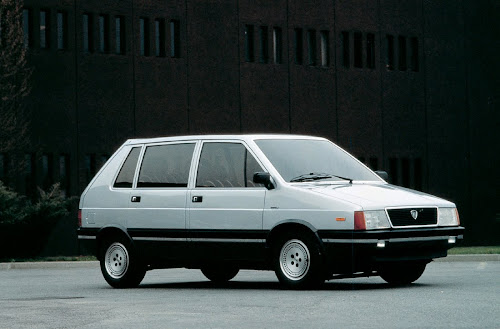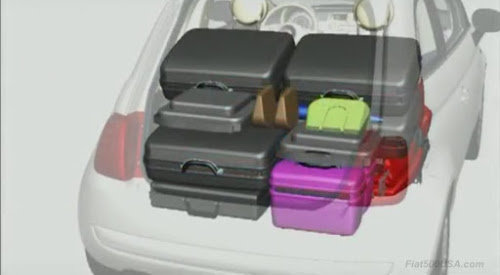The Fiat 500 can accommodate, at the same time, a driver of the 90 percentile (about 6'1") and a rear passenger of the 70 percentile (about 5'9") comfortably, within a space of only 139 inches (3.5 meters). Drivers of up to 6'6" have reported being comfortable in the 500. Fiat achieved this by drawing upon its 70 years of advanced small car design.
The drivers seat of the Fiat 500 has 38.8 inches (985mm) of headroom and 40.7 inches (1035mm) of legroom.
The rear seat of the Fiat 500 has 35.6 inches (904mm) of headroom and 32.2 inches (818mm) of legroom.
Using virtual reality in the design phase of the 500 helped Fiat solve many problems that could have added months to development time. An example is in the rear seat area. Fiat wanted to lower the hip point (H point) of the rear passenger to boost headroom, but there were problems. First was the risk that the foam of the seat cushion would be too thin, and second, that the passenger would be uncomfortably aware of the metal structure of the floor on every bump.
Two types of calculation showed that a solution to the problem did exist. One determined that an increase in the ‘bearing capacity’ of the cushion foam could absorb vertical acceleration in less space. The other was a computation of the structural rigidity of the body shell showed that the size of the rear crossbeam could be reduced. These solutions, together with a refinement to the last millimeter of the tailgate hinges and the space necessary for the tailgate to open, were able to guarantee the required amount of headroom.
Previously, solving a problem such as this would have required prototype work adding time to the development process. Using virtual reality design is one of the reasons Fiat is able to bring completed car designs to market in about 18 months time. This is exactly what is going on at Chrysler today.
The legroom versus wheelbase point to the exceptional use of space within the Fiat 500.
The relationship between the wheel center and the gas pedal, as depicted here, illustrates the space utilization within the Fiat 500. More space within the wheel base is devoted to actual passenger use.

The Fiat 128
The roominess of the Fiat 500 is the result of the evolution of Fiat's small car design philosophy. This philosophy began in 1936, when famed Fiat designer, Dante Giacosa, pioneered modern small car design with the Fiat Topolino. Giacosa created the concept of designing the car from the inside out. Starting with allocating passenger and luggage space, then room for the mechanical components. Before then, small cars were just big cars scaled down. You can read more about Giacosa here.

Fiat 128 ad clip from 1973. Space utilization is a Fiat expertise.
This concept was carried to the extreme, in 1969, with Giacosa's Fiat 128. This car set the standard (and pattern) for all modern front wheel drive cars. A full 80 percent of the car's space was devoted to the passengers and luggage. This car was advertised as being shorter than a VW Beetle but having more legroom than a Cadillac Eldorado.
Fiat's small car design philosophy underwent further advancement, with the help of legendary designer Giorgetto Giugiaro of Ital Design. During the 70's, Giugiaro was the first to introduce the concept of a more compact and taller vehicle. He concluded that to fit passengers and luggage within a given four meters length, the height of the vehicle would have to be increased. Sitting more upright allows the passengers to sit at a more comfortable angle and not have the legs bent which can result in pressure points on the body, leading to fatigue and discomfort. The above 1978 Lancia Megagamma concept car was the first car to use this concept and has influenced small car design since.
This evolving design philosophy has been applied to the 500 and helps it achieve its excellent space utilization and comfort. In particular, the taller driver is rewarded with a very roomy cabin as is illustrated below.
Taller drivers have special needs that were looked after as can be determined in this view. Stooping and bending over makes for uncomfortable entry and exit of a vehicle. Notice how this driver, in the 95 percentile (approx 6'2.5"), remains upright, his back being relatively straight as he enters the car. Once in, the door handle is easily reached.
Our 95 percentile driver is comfortably seated and is able to sit without his head touching the roof.
Our tall driver, again, notice how his arm is at a relaxed angle. He is not cramped, has a commanding view, and all controls are within reach but not on top of him. It's one of the reasons 6'6" Jeremy Clarkson enjoys the Fiat 500.
The reach to the controls have been carefully figured, The arm is outstretched, but at a natural angle. In the insert notice how one can see the A) speedo/tach, B) stereo, C) dash switches, all in that one view, the heater panel is visible by moving ones eyes down and doesn't require head movement.
The tall driver has an easy reach to his or hers controls. This is the sunroof...
power mirror switch...
The Fiat 500 offers good driver visibility. The more upright seating position helps drivers see what is in front of them closer, which comes in handy in urban environments and also helps the psychological feeling of being in control.
Right turn visibility was also looked after and is good.
Drivers visibility making a left turn.
Luggage room with the seats upright is roomy considering the size of the Fiat 500. It is deep and wide, with every inch available.
The luggage floor length is longer than its competitors, even though the 500 is shorter.
A practical illustration of the luggage capacity. The suitcases can be stowed flat.
Again, with the seats folded, the luggage floor length is longer than its competitors.
You can view the video these slides were taken from here.
With help from Fiat Group Press
Photos courtesy Fiat Group Press, Ital Design
References: Ital Design
Photos courtesy Fiat Group Press, Ital Design
References: Ital Design





















I'm 6'7" and am very happy with the room in the 500T.
ReplyDelete